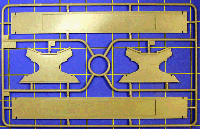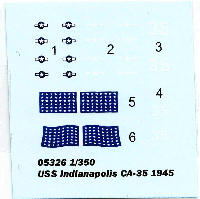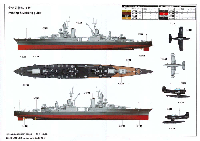| HISTORY |
|
|
The Portland class cruisers were originally intended to be little more than an Improved Northampton class. As a follow-on class to the underweight Northhamptons, originally 5 were intended, but only 2 were completed as Portlands. The other three hulls were allocated into the following New Orleans class. The Portlands had additional armor over the machinery spaces and double the secondary battery of the Northampton design, while the torpedo tubes and bulbous bow were deleted. The torpedo tubes no longer fitting into USN cruiser doctrine, and it was believed the bulbous bow would cause pounding and subsequent damage to the frames.
The USS Indianapolis CA-35 was commissioned in November of 1932. The Indianapolis worked up and trained heavily in both the Pacific and Atlantic oceans in the years preceding World War Two. She is perhaps best known for 2 events in her life; she carrying the parts for the atomic bomb dropped on Hiroshima, Little Boy, to Tinian Island in July of 1945. She is perhaps better know for her loss 2 weeks later, on 30 July 45, which led to the single largest loss of life at sea in the history of the United States Navy.
|
| HULL AND DECK |
|
|
Indianapolis, is in a two-piece full hull configuration, side-by-side halves, with internal bulkheads for stiffening. The hull halves for Indianapolis are indentical, with portholes and fairleads, but only the starboard side should feature the external aviation gasoline line from the bow tanks to the seaplane hangars. There is not a built-in waterline option; in fact, the waterline isn't indicated at all, on either the internal or external hull faces.
The raised armor belt looks correctly shaped, but without rivet heads. The stern is very dissappointing. The complex curve, arcing up from the keel to the submerged transom, is smooth; there should be a hard chine where the hull sides meet the bottom plating, just below the waterline. This error will be difficult to address.
The bilge keels are a little thick, but acceptable. There are similar etched ovals for the shafts, shaft bearings and skegs.
Hull appears very close in length and beam, and surface of the hull halves is nicely devoid of the grease and only has minor raised mold lines or other manufacturing artifacts.
|
 |
|
|
|
There are two deck pieces included- a "fore" deck and a main deck piece. The foredeck has regular wood planking, bitts and anchor details molded on. Trumpeter has reverted to molding on simplistic anchor chains on the deck, instead of including real chain. The raised barbettes for the 8" gunhouses are plain, and the foredeck barbette appears it may be too tall.
|
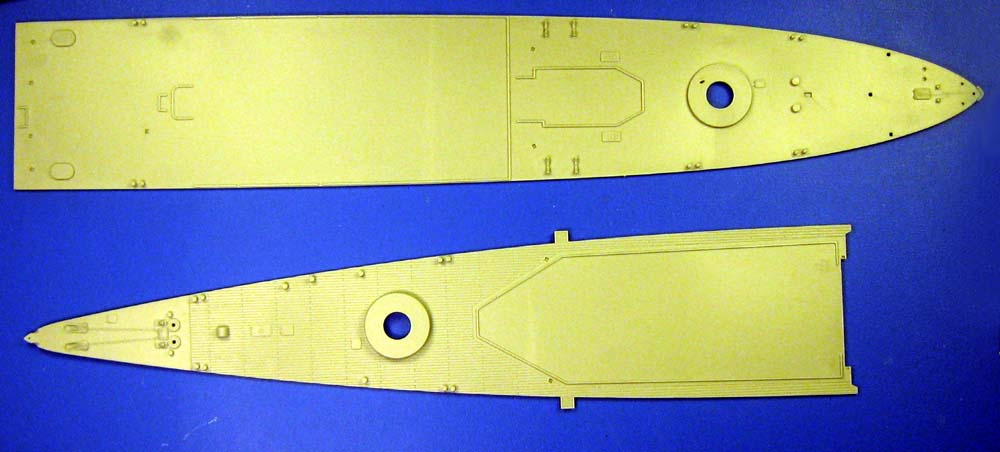 |
|
|
| SPRUE A |
|
Sprue A is focus on superstructure, and specifically on the conning tower and bridge levels. There are some additional parts to make the bases for the the Mk34 gunnery directors, and the large stern tub for the two quad 40mm Bofors.
The various decks and tubs all have splinter shields molded in. These shields are about as thin as can be reasonably expected; while thinner would be more scale appropriate, it is doubtful they would survive manufacture, transport and assembly.
|
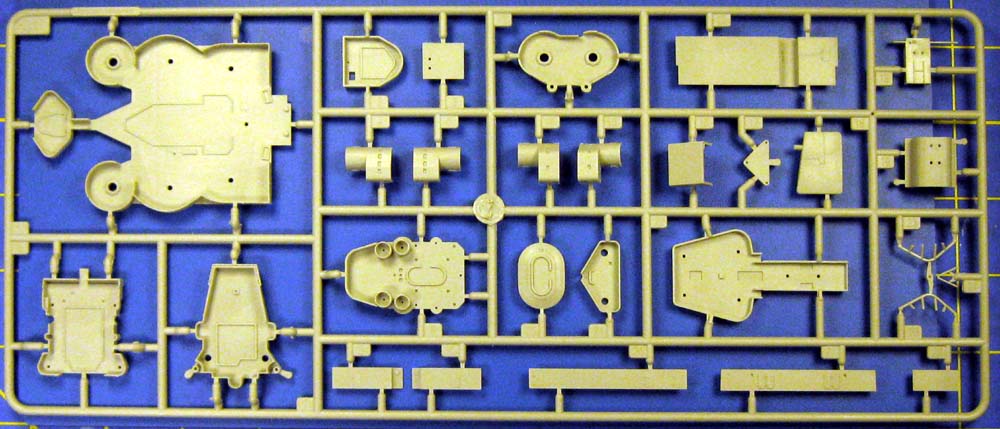 |
|
|
| SPRUE B |
|
The parts on sprue B has the two funnels for Indy, some deck houses and gun tubs, and the small pedestal which replaced the starboard aircraft catapult in July of 1945. This sprue also includes the lower gundeck, just abaft the aircraft hangar, as well as the bulkheads for the hangar and after superstructure. Trumpeter opted to not have these bulkheads molded as part of the hull, as this is fitting with their construction style of assembling a complete superstructure, then placing it on the waiting hull.
|
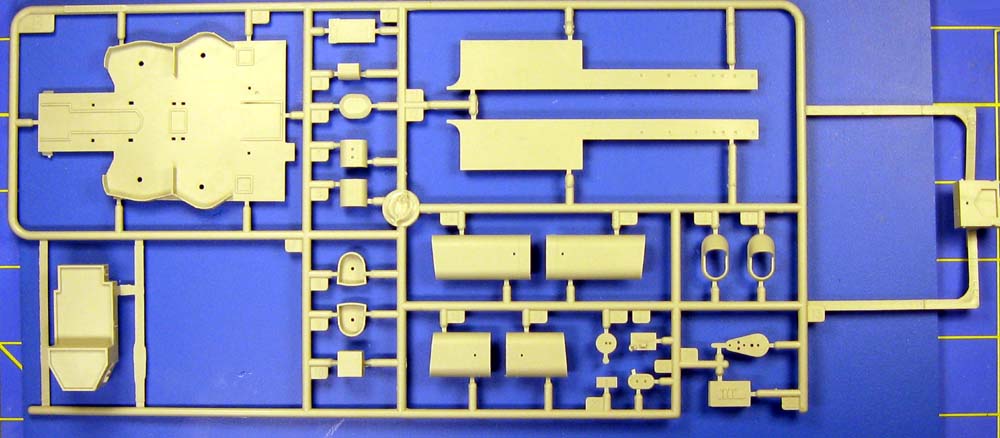 |
|
|
| SPRUE C |
|
Sprue C as many delicate, thin parts, and the entire sprue comes wrapped in protective foam padding. The long, thin parts include the gantry legs for the aircraft crane, the four prop shafts with molded-in skegs, yards and masts, and steam pipes. Part C10, primary leg of the tripod mainmast, is also on this sprue, but should be hexagonal for the 1945 Indy, not round.
Some othe parts on this sprue include clipping rooms and the base level of the conning tower/bridge. The four shaft bearings with "V" struts are also on this sprue. The bearings are small with a nice taper, but the struts are rather thick.
|
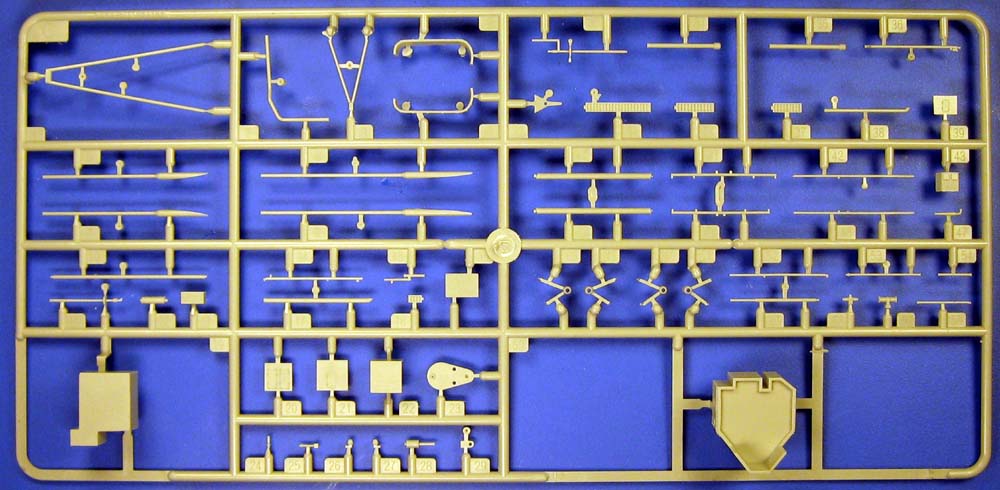 |
|
|
| SPRUE D x2 |
|
This sprue has an assortment of details for Indianapolis, ranging from hangar doors to propellors, range finders to smoke generators. The propellors have the correct number of blades, and the chord looks good, but the hubs are too long and blunt. The various ladders are ok for plastic, but Trumpeter has included photo-etched upgrades for most of them. The aircraft catapult and pedestal are also on this sprue. The two halves of the pedestal look ok, but the plastic components of the catapult itself are pretty unadorned. The catapult will be mostly built from photoetch- there is not an all-plastic option in this kit.
The hangar doors can only be installed in the closed postion, which is logical, since Trumpeter opted to not model an interior for the two bays of the the aircraft hangar.
The biggest error on this sprue concerns the main fire control system. The Mk34's are acceptable, but Trumpeter has only included the Mk8 radars (made of a plastic core with photoetched details). However, if this kit is supposed to represent a 1945 Indianapolis at the time of her transport of the atomic bomb parts and her sinking; she had received upgrades to the streamlined Mk13 radars at that time.
The 5" directors, the Mk34's, are ok, but leave some room for improvement. Trumpeter has molded the lens for the 36" searchlights seperately from the body, but still molded the lens from grey, instead of clear, plastic.
|
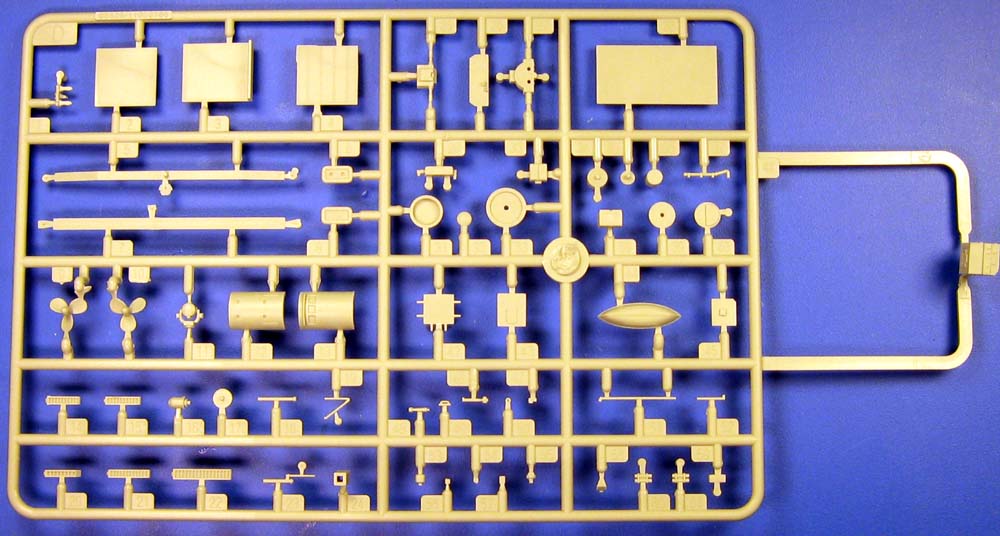 |
|
|
| SPRUE E x4 |
|
This is the "weapons" sprue for Indianapolis. There are four of this sprue included, each having 20mm's, 40mm's, 5"/25's and 8" guns. Filling out the rest of the sprue are additional items such as a paravane, signalling lamps and ready service ammunition bins.
The twin 20mm Oerlikons are plain and oversized. Trumpeter- like every current manufacturer- insists on mounting these twins on pedestals instead of correct Mk 7 tripod stand. Each 5"/25 open gun mount is built from seven parts, and includes a fuse-setting machine with 3 rounds in place. These guns have decent detail, but do not have open muzzle- but are a dramatic improvement over those seen on earlier Trumpeter releases. Trumpeter's practice of not always reusing previously issued weapons paid off in this case. The same can be said for the quad 40mm Bofors. While these guns are still far from the best offerings available, they also are an inprovement over those seen previously.
The 8"/55 guns and gun houses have good details. The 8" barrels have open muzzles, and are molded directly on the curved mantlet. The gunhouse has a few minor issues; the overall gunhouse appears oversized. The shutters on the front should be flush, and closer to the barrels; they are centered on each side. There are also some rough molding leftovers, including mold lines and flash that will require each gunhouse to receive some TLC. The rangefinders, however, are very disappointing (E25, E26)
|
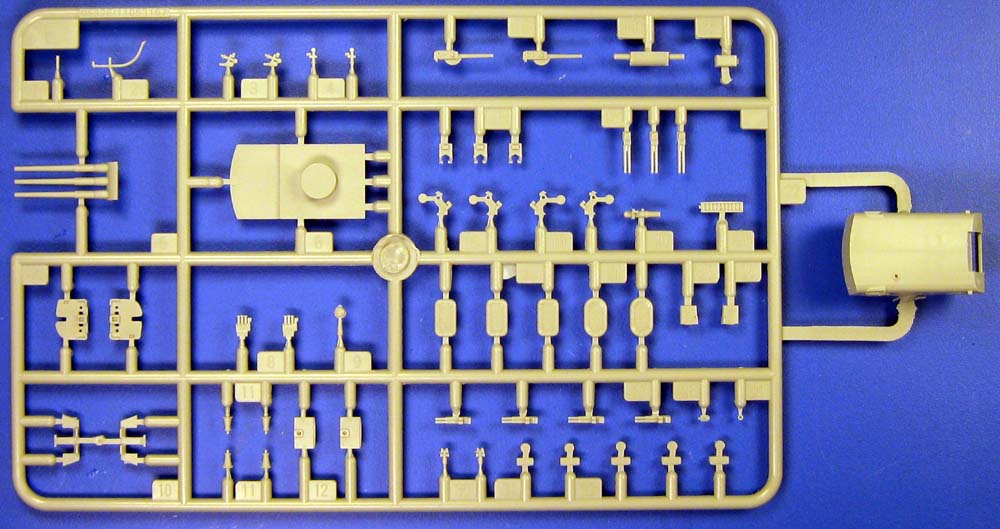 |
|
|
| SPRUE F |
|
This sprue 01 level of the forward superstructure, the bulkheads for the hull, and the nameplate. The superstructure has some basic details, like portholes and watertight doors. The 40mm tubs are oddly shaped, but the bases for the quad Bofors aren't bad.
|
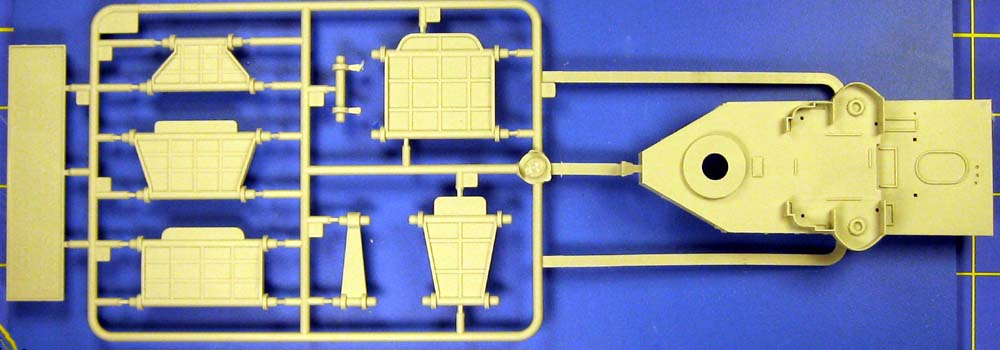 |
|
|
| SPRUE G |
|
This small sprue has two deckhouses.
|
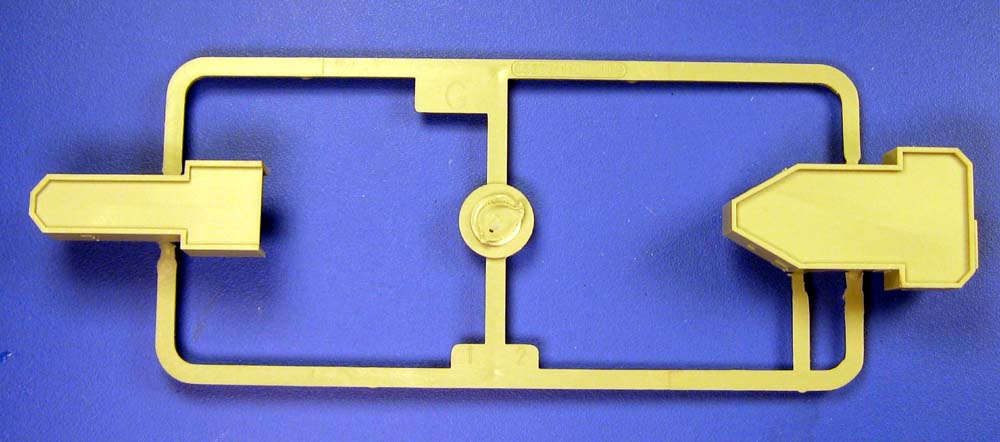 |
|
|
| AIRCRAFT x2 |
|
Two clear sprues of SC-1 Seahawk reconnaissance floatplanes are included. These seaplanes do not have a folded-wing option.
|
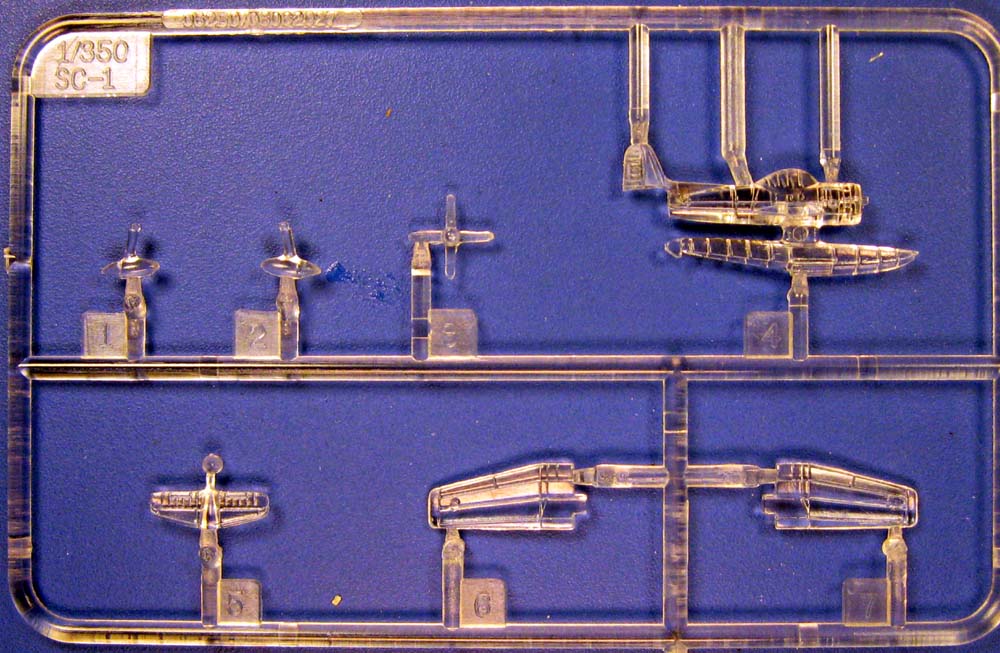 |
|
|
| PHOTOETCH |
|
There are three frets of photoetch included in this kit; two of fret "A", and one of "B". These frets have the parts you'd expect from PE included in a kit; floater net baskets, ladders, and radars, not to forget the crane and catapult. As mentioned in the details about the sprue "D", there are dipoles for a Mk8 radar included. There are only enough Mk28 radar antennas for the two Mk33 directors; none are included for the quad 40mm Bofors guns, which would be appropriate for a 1945 Indianapolis.
Also included are some nice bases for the 5" guns, shields for the twin 20mm's, the support lattices for the tripod mainmast, and some triangluar support plates.
|
|
|


